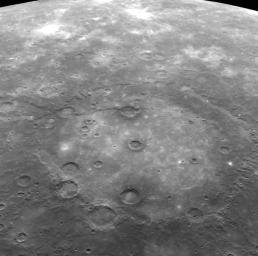
|
Rembrandt Revisited
- Click the image above for a larger view
- Full-Res JPEG (512 x 508) (38.7 kB)
- Full-Res TIFF (512 x 508) (260.6 kB)
Caption:
This limb image shows Rembrandt , the second largest impact basin on Mercury after Caloris . Discovered during the second MESSENGER flyby, Rembrandt is one of the youngest impact basins on Mercury, as indicated by the relatively low density of impact craters on its rim. A large lobate scarp trending from the southwest to the north crosscuts Rembrandt and several of the smaller craters that have impacted the smooth interior plains.
Date acquired:
August 07, 2011
Image Mission Elapsed Time (MET):
221198580
Image ID:
601688
Instrument:
Wide Angle Camera (WAC) of the Mercury Dual Imaging System (MDIS)
WAC filter:
7 (748 nanometers)
Center Latitude:
-32.95°
Center Longitude:
84.90° E
Resolution:
1756 meters/pixel
Scale:
The large impact basin is ~715 km (444 mi) in diameter.
Incidence Angle:
46.3°
Emission Angle:
48.7°
Phase Angle:
95.0°
Background Info:
The MESSENGER spacecraft is the first ever to orbit the planet Mercury, and the spacecraft's seven scientific instruments and radio science investigation are unraveling the history and evolution of the Solar System's innermost planet. Visit the Why Mercury? section of this website to learn more about the key science questions that the MESSENGER mission is addressing. During the one-year primary mission, MDIS is scheduled to acquire more than 75,000 images in support of MESSENGER's science goals.
These images are from MESSENGER, a NASA Discovery mission to conduct the first orbital study of the innermost planet, Mercury. For information regarding the use of images, see the MESSENGER image use policy .
Cataloging Keywords:
| Name | Value | Additional Values |
|---|---|---|
| Target | Mercury | |
| System | ||
| Target Type | Planet | |
| Mission | MESSENGER | |
| Instrument Host | MESSENGER | |
| Host Type | Orbiter | |
| Instrument | Mercury Dual Imaging System (MDIS) | |
| Detector | Wide Angle Camera (WAC) | |
| Extra Keywords | Crater, Grayscale, Impact, Radio | |
| Acquisition Date | ||
| Release Date | 2011-08-16 | |
| Date in Caption | 2011-08-07 | |
| Image Credit | NASA/Johns Hopkins University Applied Physics Laboratory/Carnegie Institution of Washington | |
| Source | photojournal.jpl.nasa.gov/catalog/PIA14549 | |
| Identifier | PIA14549 | |
